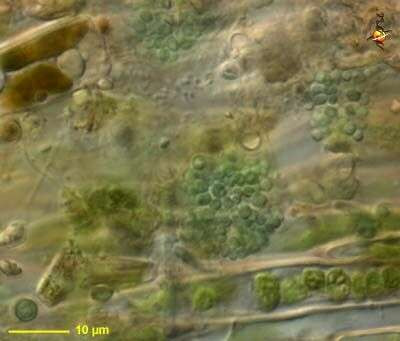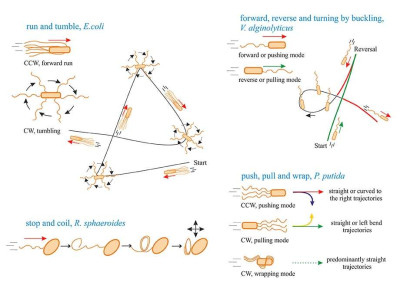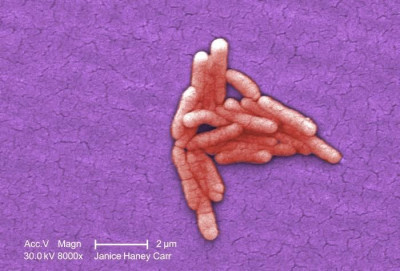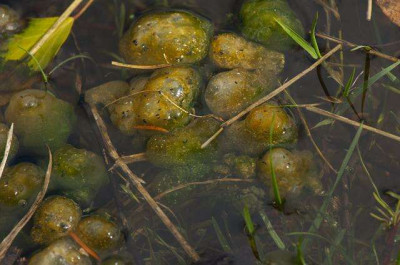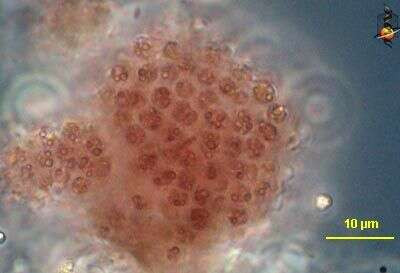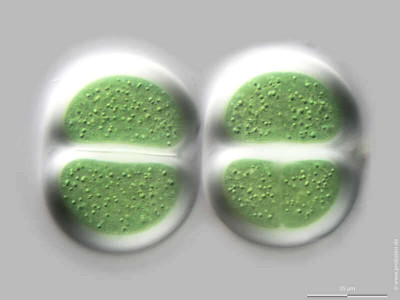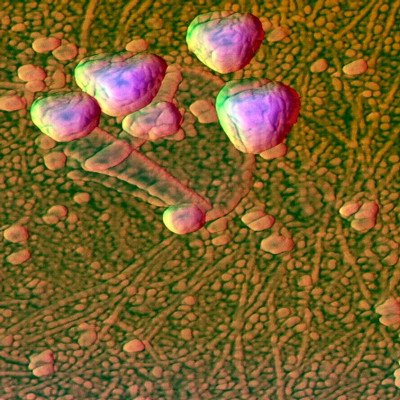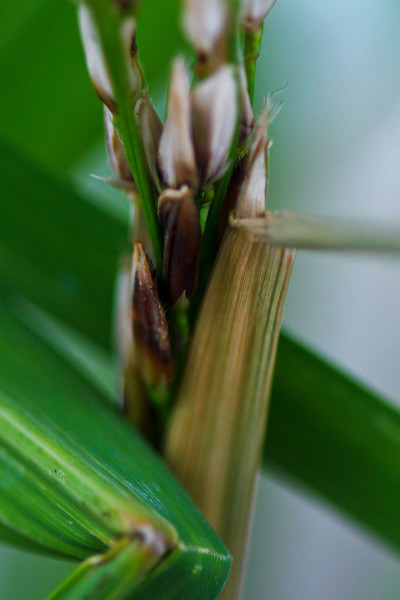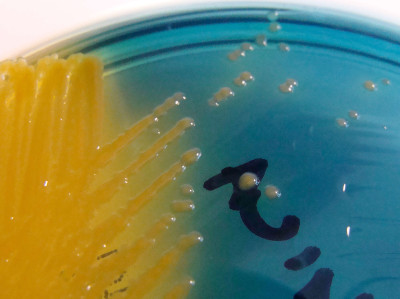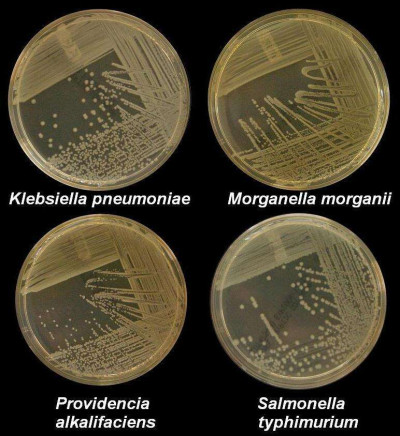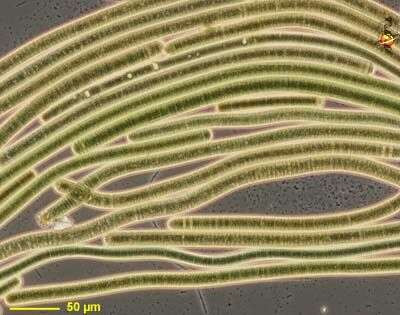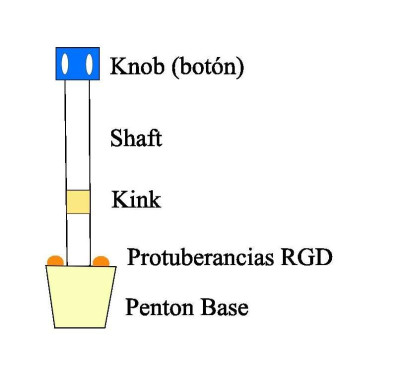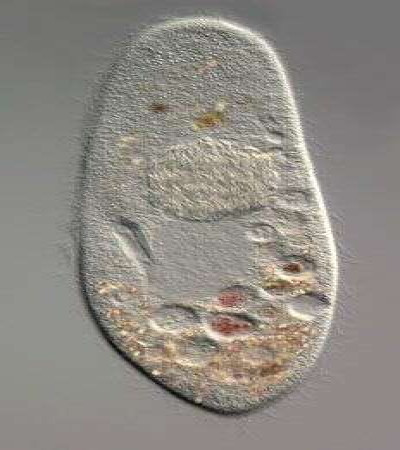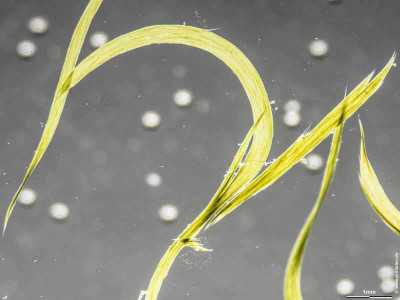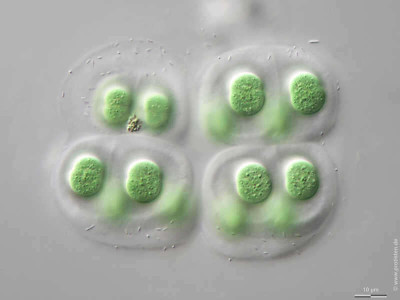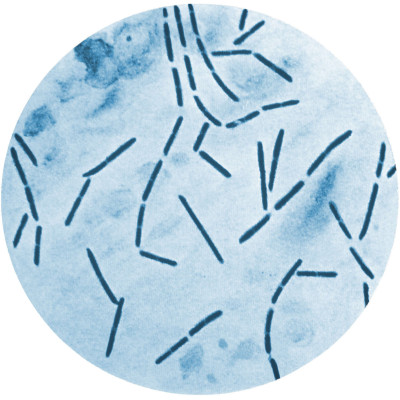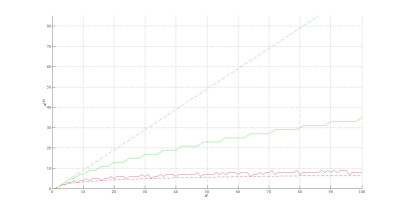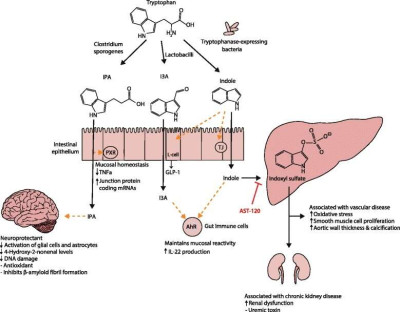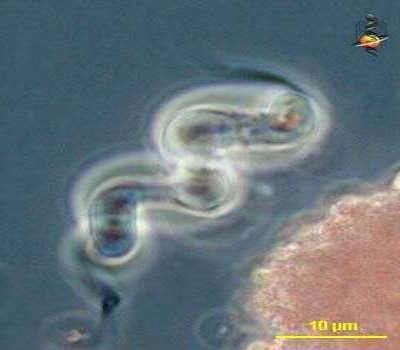Chroococcus tentative identification. Coccoid blue green algal cells. Found as one of several cyanobacterial epibionts on the leaves of the moss Hygrohypnum, a site which seems to be a focus for nitrogen fixation. Differential interference contrast.
Michele Bahr and David Patterson, micro*scope
02 Aug 2024
Schematics (not to scale) of different swimming strategies. Run and tumble from Escherichia coli; forward, reverse, and turning by buckling of Vibrio alginolyticus (adapted from Son et al., 2013); stop and coil from Rhodobacter sphaeroides (adapted from Armitage and Macnab, 1987; Armitage et al., 1999); push, pull, and wrap from Pseudomonas putida (adapted from Hintsche et al., 2017). The direction of bacteria movement is indicated by the arrows. References: Son, K., Guasto, J. S., and Stocker, R. (2013). Bacteria can exploit a flagellar buckling instability to change direction. Nat. Phys. 9, 494–498. doi: 10.1038/nphys2676 Armitage, J. P., and Macnab, R. M. (1987). Unidirectional, intermittent rotation of the flagellum of Rhodobacter sphaeroides. J. Bacteriol. 169, 514–518. doi: 10.1128/jb.169.2.514-518.1987 Armitage, J. P., Pitta, T. P., Vigeant, M. A., Packer, H. L., and Ford, R. M. (1999). Transformations in flagellar structure of Rhodobacter sphaeroides and possible relationship to changes in swimming speed. J. Bacteriol. 181, 4825–4833. Hintsche, M., Waljor, V., Großmann, R., Kühn, M. J., Thormann, K. M., Peruani, F., et al. (2017). A polar bundle of flagella can drive bacterial swimming by pushing, pulling, or coiling around the cell body. Sci. Rep. 7:16771. doi: 10.1038/s41598-017-16428-9.
Julio Bastos-Arrieta, Ainhoa Revilla-Guarinos, William E. Uspal and Juliane Simmchen, Wikimedia Commons
25 Jul 2024
Under a moderately-high magnification of 8000X, this colorized scanning electron micrograph (SEM) revealed the presence of a small grouping of Gram-negative Salmonella typhimurium bacteria that had been isolated from a pure culture.
Public Health Image Library
05 Aug 2024
Nostoc pruniforme is a specific species within the Nostoc genus, known for its distinctive spherical or grape-like colonies. Like other Nostoc species, it is a cyanobacterium that contributes significantly to nitrogen fixation and primary production in its habitats.
S Drozd Lund, Biopix Nature Photos
24 Jul 2024
Carbon nano-scrolls (CNS) represent probably the latest carbon-nanomaterial form developed in laboratory. This type of nanostructure has been obtained by applying shear-friction forces to graphite nanoplatelets (GNPs) between the fibrous structure of two bi-axially oriented polypropylene (BOPP) films [1].
01 Jul 2024
Thiocystis is a red sulphur bacterium (or purple sulphur bacterium). It is found in sediments above the reduced zone. It oxidizes hydrogen sulphide producing elemental sulphur which is deposited within the bacterial cell as granules of sulphur. Forms aggregates and individual cells are often hard to distinguish. The cellular nature of these aggregates is hard to determine at first glance. This detail shows that the mass is made of individual cells and the cells have granular inclusions. Phase contrast.
David Patterson, Linda Amaral Zettler and Virginia Edgcomb, micro*scope
24 Jul 2024
Chroococcus turgidus Scale bar indicates 25 µm. Sample from Bog Waasenmoos Pass Thurn near Mittersil, Tyrol, Austria. Sampling date 10/2019. The image was built up using several photomicrographic frames with manual stacking technique. Images were taken using Zeiss Axioplan with Olympus OM-D M5 MKII. Image under Creative Commons License V 3.0 (CC BY-NC-SA). Place name: Bog Waasenmoos Pass Thurn near Mittersil (Tyrol, Austria) Latitude: 47.30234117 Longitude: 12.41751194 Multiebenen-Abbildung, manuell gestapelt. Der Messbalken markiert eine Länge von 25 µm. Probe aus dem Waasenmoos bei Pass Thurn Nähe Mittersil, Tirol. Datum der Aufsammlung: 10/2019. Mikrotechnik: Zeiss Axioplan, Kamera: Olympus OM-D M5 MKII. Creative Commons License V 3.0 (CC BY-NC-SA). For permission to use of (high-resolution) images please contact postmaster@protisten.de.
Wolfgang Bettighofer, protisten.de
29 Jul 2024
Bacterial sheath brown rot, also known as bacterial sheath rot, is a disease that affects rice plants. It is caused by the bacterium Pseudomonas fuscovaginae. This disease is particularly significant in rice-growing regions as it can lead to substantial yield losses and affect the quality of the rice grains.
International Rice Research Institute (IRRI), Flickr
23 Jul 2024
Summary.mw-parser-output table.commons-file-information-table,.mw-parser-output.fileinfotpl-type-information{border:1px solid #a2a9b1;background-color:#f8f9fa;padding:5px;font-size:95%;border-spacing:2px;box-sizing:border-box;margin:0;width:100%}.mw-parser-output table.commons-file-information-table>tbody>tr,.mw-parser-output.fileinfotpl-type-information>tbody>tr{vertical-align:top}.mw-parser-output table.commons-file-information-table>tbody>tr>td,.mw-parser-output table.commons-file-information-table>tbody>tr>th,.mw-parser-output.fileinfotpl-type-information>tbody>tr>td,.mw-parser-output.fileinfotpl-type-information>tbody>tr>th{padding:4px}.mw-parser-output.fileinfo-paramfield{background:#ccf;text-align:right;padding-right:0.4em;width:15%;font-weight:bold}.mw-parser-output.commons-file-information-table+table.commons-file-information-table,.mw-parser-output.commons-file-information-table+div.commons-file-information-table>table{border-top:0;padding-top:0;margin-top:-8px}@media only screen and (max-width:719px){.mw-parser-output table.commons-file-information-table,.mw-parser-output.commons-file-information-table.fileinfotpl-type-information{border-spacing:0;padding:0;word-break:break-word;width:100%!important}.mw-parser-output.commons-file-information-table>tbody,.mw-parser-output.fileinfotpl-type-information>tbody{display:block}.mw-parser-output.commons-file-information-table>tbody>tr>td,.mw-parser-output.commons-file-information-table>tbody>tr>th,.mw-parser-output.fileinfotpl-type-information>tbody>tr>td,.mw-parser-output.fileinfotpl-type-information>tbody>tr>th{padding:0.2em 0.4em;text-align:left;text-align:start}.mw-parser-output.commons-file-information-table>tbody>tr,.mw-parser-output.fileinfotpl-type-information>tbody>tr{display:flex;flex-direction:column}.mw-parser-output.commons-file-information-table+table.commons-file-information-table,.mw-parser-output.commons-file-information-table+div.commons-file-information-table>table{margin-top:-1px}.mw-parser-output.fileinfo-paramfield{box-sizing:border-box;flex:1 0 100%;width:100%}} Description: Aeromonas hydrophila isolated from blood culture from a patient with severe diarrhoea. Date: 28 February 2012, 20:05.
Nathan Reading, Wikimedia Commons
25 Jul 2024
Four nutrient agar plates growing colonies of common Gram negative bacteria. Each independent colony arises from an individual bacterium. The size, color, shape and form of the colonies are characteristic of the bacterial species, its specific genetic makeup, and the environment which supports its growth.
Eukaryotica, Wikimedia Commons
25 Jul 2024
Lyngbya is a filamentous blue-green alga (cyanobacterium), fairly substantial and usually found with a sheath around each filament. Phase contrast micrograph.
David Patterson, micro*scope
29 Jul 2024
A mass of bacterial endosymbiont Holospora undulata (ex Hafkine, 1890) occupying the micronucleus of Paramecium caudatum (Ehrenberg,1833).DIC.
William Bourland, micro*scope
24 Jul 2024
Aphanizomenon flos-aquae Scale bar indicates 1 mm. Sample from the wetland Seekamper Seewiesen in Schilksee (Kiel). Sampling date 8/2021. Images were taken using Olympus stereomicroscope SZX16 with Olympus OM-D M5 MKII.
Wolfgang Bettighofer, protisten.de
01 Aug 2024
Chroococcus subnudus Scale bar indicates 10 µm. Sample from Bog Waasenmoos Pass Thurn near Mittersil, Tyrol, Austria. Sampling date 10/2019. The image was built up using several photomicrographic frames with manual stacking technique. Images were taken using Zeiss Axioplan with Olympus OM-D M5 MKII.
Wolfgang Bettighofer, protisten.de
07 Aug 2024
This illustration depicts a photomicrographic view of a methylene blue-stained culture specimen revealing the presence of numerous Clostridium septicum bacteria.
CDC, PHIL, Wikimedia Commons
13 Aug 2024
Lower bound on the bitstring assembly index (red), log2(𝑁) (red, dash–dot), conjectured upper bound on the bitstring assembly index (green), and 𝑁−1 (green, dash–dot) for the bitstring length 0≤𝑁≤100.
28 Aug 2024
This diagram shows the metabolism of tryptophan to indole and indole derivatives in the colonic lumen. Clostridium sporogenes metabolizes indole into 3-indolepropionic acid (IPA), a highly potent neuroprotective antioxidant. In the intestine, IPA binds to pregnane X receptors (PXR) in intestinal cells, thereby facilitating mucosal homeostasis and barrier function. Following absorption and distribution to the brain, IPA confers a neuroprotective effect against cerebral ischemia and Alzheimer’s disease. Lactobacillus species metabolize indole into indole-3-aldehyde (I3A) which acts on the aryl hydrocarbon receptor (AhR) in intestinal immune cells, in turn increasing interleukin-22 (IL-22) production. AhR activation markedly affects in gut immunity by supporting epithelial barrier function, increasing immune tolerance to commensal microbiota, and protecting against pathogenic infections. Indole itself acts as a glucagon-like peptide-1 (GLP-1) secretagogue in intestinal L cells and as a ligand for AhR. Indole can also be metabolized by the liver to indoxyl sulfate, a compound that is detrimental to human health in high concentrations. Accumulation of indoxyl sulfate in blood plasma is toxic and associated with vascular disease and renal dysfunction. AST-120 (activated charcoal), an intestinal sorbent that is taken by mouth, adsorbs indole, in turn decreasing the concentration of indoxyl sulfate in blood plasma. Date: 21 April 2016. Source: (April 2016). "Microbial metabolism of dietary components to bioactive metabolites: opportunities for new therapeutic interventions". Genome Med 8 (1): 46. DOI:10.1186/s13073-016-0296-x. PMID 27102537. PMC: 4840492. Figure 1: Molecular mechanisms of action of indole and its metabolites on host physiology and disease.
Zhang LS, Davies SS, Wikimedia Commons
24 Jul 2024
Thiospirillum is one of the sulphur bacterium. Rather like Spirillum, cells take the form of short-cork-screw and have flagella at both ends of the cells. The flagella occur in very substantial tufts so can be seen easily seen with the light microscope. This cell was rather large.
David Patterson, Linda Amaral Zettler and Virginia Edgcomb, micro*scope
25 Jul 2024
 Encyclopedia
Encyclopedia
